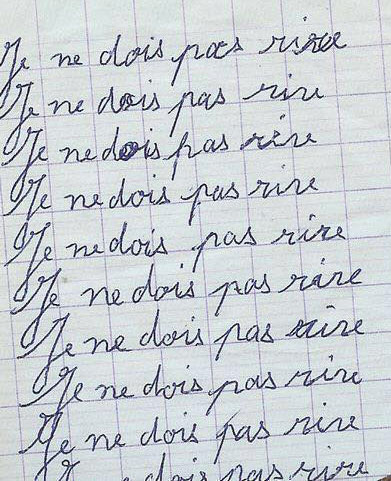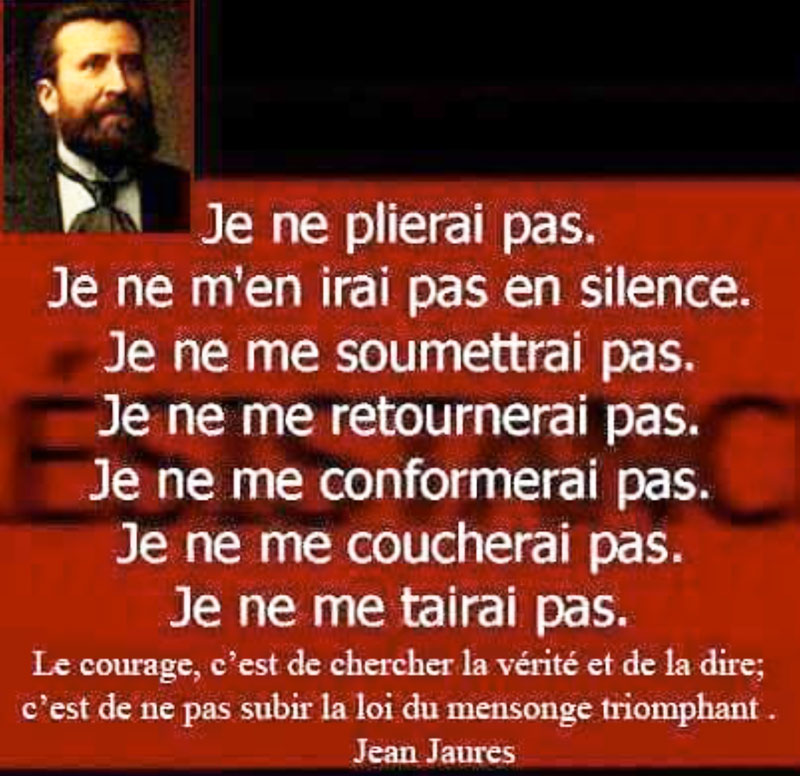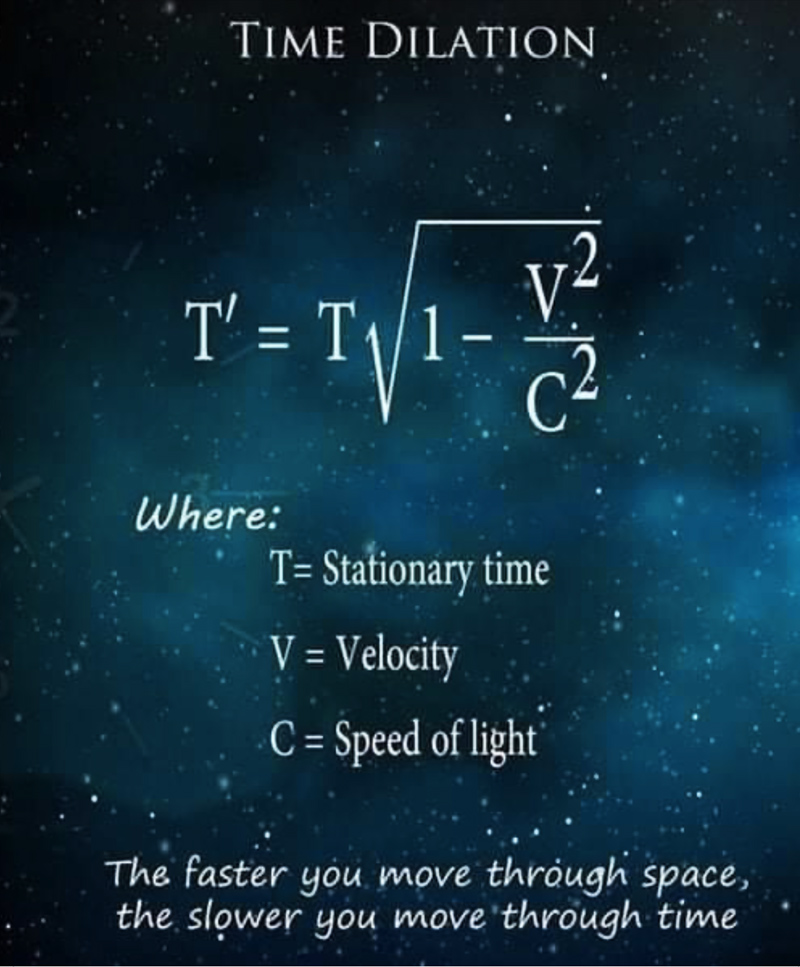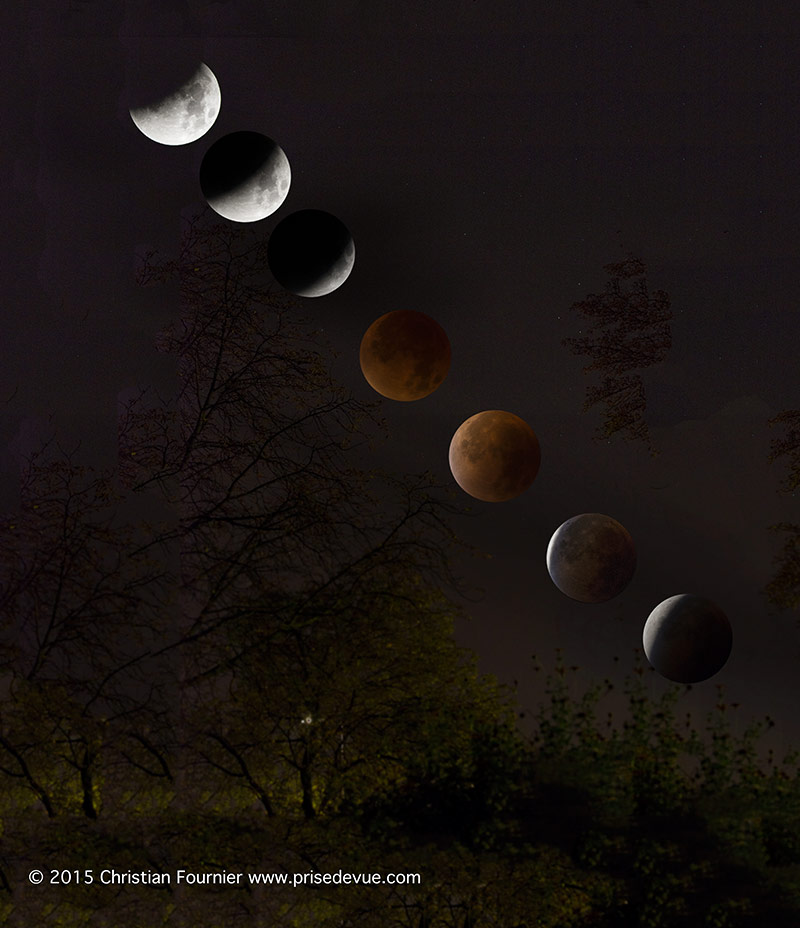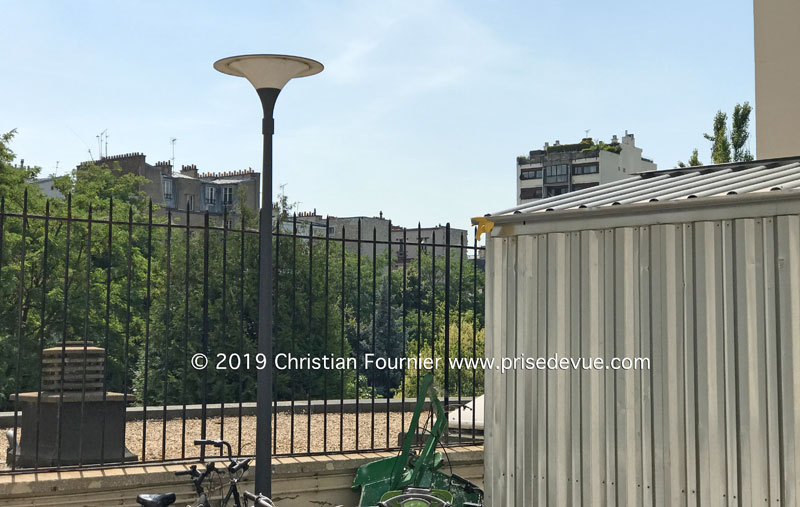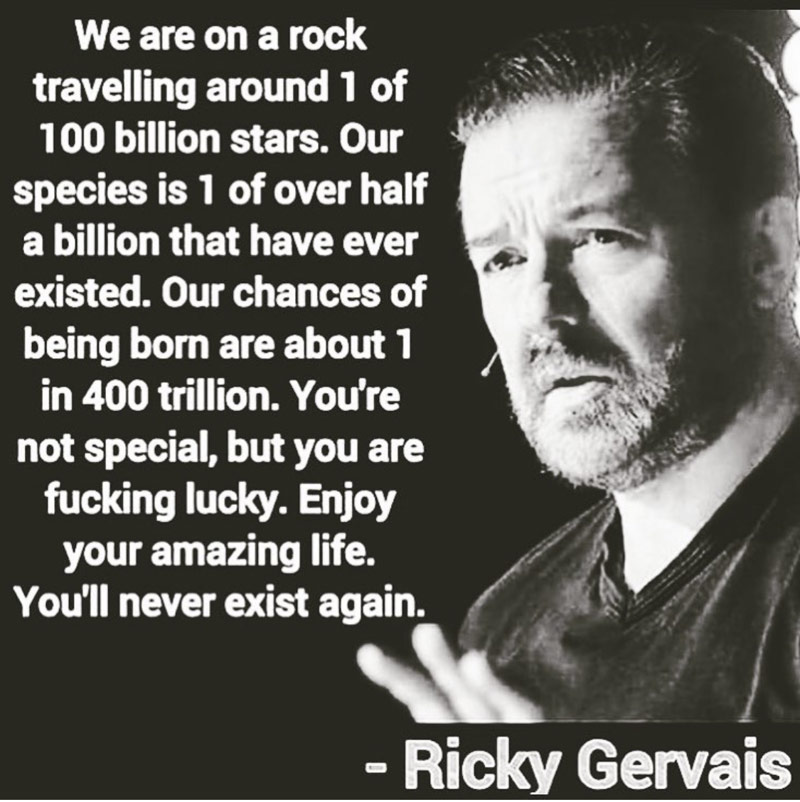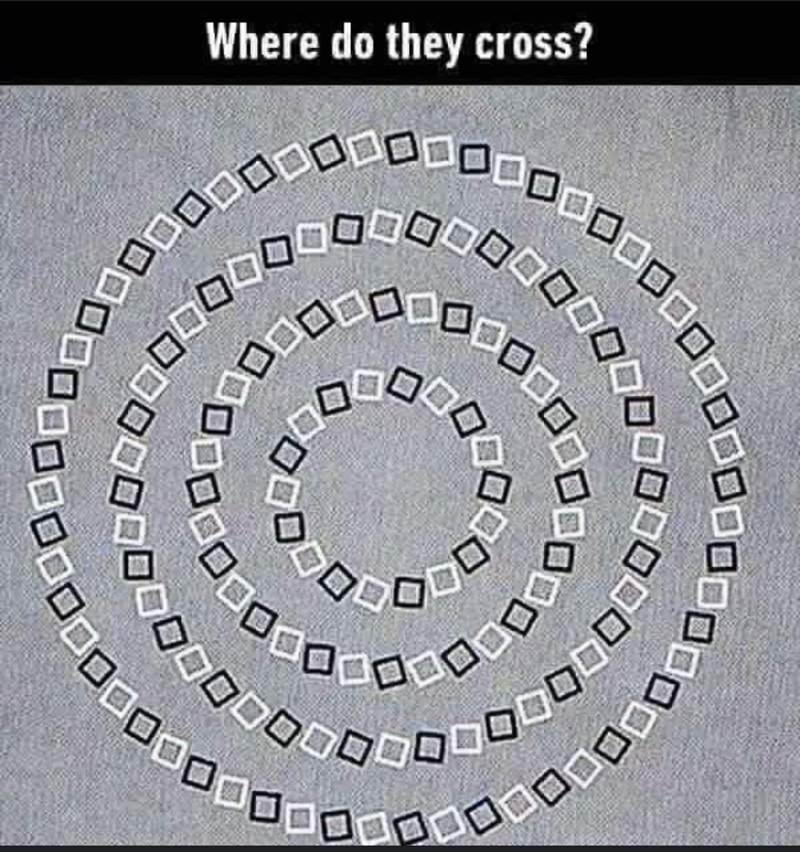|
Page 9: 1975, Degree in Mathematics at the University of Amiens. Then Maths teacher in Arras, France.
|
 Then the Rolleiflex Single-Lens, 120 format (the negatives measured 6x6cm), of very good quality, but it had some parallax issues due to the 2 lenses and difficult to focus in low light conditions. Here I am in Grenoble to take photos at my brother Dominique’s wedding.  |
Puis le Rolleiflex mono objectif, format 120 (les négatifs font
6x6 cm), très bonne qualité, mais problème de parallaxe dû aux
2 objectifs et mise au point difficile en basse lumière. |
|
In France, here is how, and probably like you, I learned trigonometry, around 1970 in Arras in the Pas-de-Calais: - "Take your notebooks, definition: The tangent of an angle is the ratio of the length of the opposite side to the length of the adjacent side. To be learned by heart for next week ". Not funny. As soon as I became a math teacher, I applied the English methods. The principal called me regularly to his office: Eratosthenes calculated the circumference of the Earth in the third century BC. It is an extraordinary tale: Eratosthenes (276-194BC) was a geographer, mathematician, and director of the library of Alexandria. He had heard travelers say that in Syene, at noon on June 21st, you could see the image of the sun reflected in the bottom of a well. This meant of course that the Sun was precisely vertically above the well. So on June 21st, at noon in Alexandria, Eratosthenes measured the length of the shadow of one of the city’s obelisks. The Greeks had already figured out that the world was round, for they were great navigators, often in armadas, and they had remarked that when a boat disappeared over the horizon, it was always the prow that disappeared first, no matter where or in what direction they were traveling. From the Atlantic to the Black Sea, the same thing happened, and only a sphere could explain it. They had also understood that a lunar eclipse happened when the Earth’s shadow was projected onto the moon and that this shadow was circular. They had even understood that the sun’s rays, crossing such a far distance, were parallel. Which allowed him to draw up the following diagram :  Angles A and B are equal as they are interior angles. So that gives him the angle and the opposite side of an isosceles triangle. Far from being an idiot, Eratosthenes knew that he only needed to calculate the two unknown sides, in this case, the SUN’S RADII! As you well may know, a triangle has only 6 variables: 3 sides and 3 angles. It is evident that once you have 3 of those variables, you can find them all. If you have an angle and two sides, your triangle is well-defined. So there must be calculations that would let you find the other variables. He was right, and so he invented “Trigonometry”. Eratosthenes was able to find the length of the Earth’s circumference: 39,375km which isn’t too far off. Pretty good job for 300BC. Bravo, Eratosthenes. Thanks to you, we can learn this so-called Trigonometry. Hurray! I learned all of these motivating stories by talking to other math students I met while working for the National Trust. |
| « We have known the radius of Earth since the time of the Greek mathematician and geographer Eratosthenes, about 240 BC. Every year at noon on June 21, the Sun passed directly overhead at Syene, Egypt. Eratosthenes knew this fact. At that same moment, he measured the Sun to be 7.2° off vertical in Alexandria, which is directly north of Syene. Aristotle had argued that Earth, no matter what its orientation, always casts a circular shadow on the Moon during an eclipse of the Moon. The only object that always casts a circular shadow is a sphere; thus, Eratosthenes knew that Earth must be a sphere. He also understood that the 7.2° shift in the altitude of the Sun, as measured from the two cities at the same time, was due to the curvature of Earth’s surface, meaning that the two cities were separated by 7.2° of latitude, or about 1/50 of Earth’s entire 360° circumference. Hire someone to pace off the distance from Alexandria to Syene, multiply by 50, and you have the circumference of Earth—about 25,000 miles. Divide by 2π and you have the radius. It was easy, once someone figured out how to do it! » (de « Welcome to the Universe: An Astrophysical Tour » par Neil deGrasse Tyson, Michael A. Strauss, J. Richard Gott) |
Thales’s theorem. |
Legend has it that Thales of Miletus (about 626-547 BC) was invited by King Amasis, warned of his great knowledge. The king declared that he did not know the height of the fantastic pyramids already almost two thousand years old. Thales planted his cane at noon in the sand vertically and said to the king: "The shadow of my cane is exactly equal to its height, and so must your pyramid." .... In geometry, Thales's theorem, or intercept theorem, states that on a plane, a line parallel to one of the sides of the triangle cuts it into two similar triangles. The lines AP and BC are parallel so the triangles DBC and DPA are similar and the sides AP, PD, AD are proportional to the sides BC, BD, and CD. As we can measure the lines PD, BC, CB and BD, we can calculate AP. Magic? No, Mathematics. Bravo, Thales.  At the Parc de Sceaux, I take this opportunity to illustrate my simplified version of Thalès' theorem. I position myself so that my shadow ends at the same place as that of the tree. |
I must not laugh Other examples of the French national education of that time: Program of history in 3rd: the French revolution of 1789. Program of history in second: the French revolution of 1789. The same teacher of English from second to final, Mr. Taquet: for three years, we have never pronounced a single word of English !!!
For two years (Math Sup and Math Spé), the word math teacher spoke only with the gifted class, ignoring the other 40 students. The physics teacher said he was against the theory of relativity and did not teach it. I learned everything myself. My college was named "Lycée Robespierre" after the famous French revolutionary guy. I think this name is inappropriate. Aviation SWIMMING |
|
 I build a model of the caravel, the Pinta, one of the three Christopher Columbus ships, during his trip to "America". The other boats were called: Niña and Santa María. Christopher Columbus' father would have had sufficient financial means to send him to the University of Pavia where he studied, in particular, cosmography, astrology and geometry. Like me, and I went to America too. Well, I learn that when other people take a picture of me, I am very often blurry. |
Learning maths and physics helps to see the difference between the rational and the irrational. Ignorance leads to fear, fear leads to hatred, hatred leads to violence. |
France loses a good teacher, England gains a great photographer. I decided to go for a change of culture and language. Again I worked some odd jobs across Europe: volunteer work cleaning up the rubble after an earthquake in Monteaperta di Friuli, near Udine, Italy; photographer for Club Med in Corfou, Greece; photographer/videographer for Butlin’s Holidays Ltd, Bognor Regis Sussex (we had to ask the guests to pay for their photo before taking it! Club Med and cruiseships were easy after that!); salesman/demonstrator for Electrosonic slide projectors in London, I went to Norway to see Ina who I met at Friday Bridge, etc…
Maths and science levels in school: French chilldren are the worst of all Europe in 2020. |
Math teacher in France: an endangered profession (2015) Les performances en mathématiques des élèves en France, aussi bien au primaire que dans le secondaire. Dans les deux cas, le niveau global est en sérieuse baisse. La situation au primaire est encore plus inquiétante. Dans la dernière étude internationale (TIMSS) qui évaluait le niveau en mathématiques des élèves de CM1, on trouvait la France en dernière position du classement avec un score moyen de 488 points quand la moyenne européenne était de 527 points. Ce résultat est très loin de la perception que l’on peut avoir du niveau en mathématiques de notre pays, il devient donc urgent d’agir pour inverser cette tendance. Le problème en France n’est pas celui de la « quantité » mais bien celui de la « qualité » d’enseignement. C’est d’ailleurs sur cet aspect qualitatif que la situation devient particulièrement préoccupante. Les difficultés en mathématiques ne se cantonnent pas aux élèves, le mal est plus profond et concerne aussi nos enseignants. Ainsi, les connaissances en mathématiques de ceux qui exercent dans le premier degré (en maternelle et au primaire) sont insuffisantes quand une crise de vocation touche certaines académies du second degré (collège et lycée). Sur le premier degré, ce constat n’est pas surprenant quand on sait que plus de 80% des étudiants qui se prédestinent à devenir professeur des écoles sont titulaires d’une licence en Lettres, Arts ou Sciences Humaines. Ils ont, pour un grand nombre d’entre eux, en héritage de leur scolarité antérieure, des difficultés, voire une aversion, envers les mathématiques. Ainsi, toujours selon l’étude TIMSS, les enseignants du primaire en France sont moins nombreux à déclarer se sentir à l’aise ou très à l’aise lorsqu’il s’agit d’améliorer la compréhension des mathématiques des élèves en difficulté (61 % contre 79 % en moyenne). Il en est de même lorsqu’il s’agit d’aider les élèves à comprendre l’importance des mathématiques (70 % contre 88 % en moyenne) ou de donner du sens aux mathématiques (72 % contre 85 % en moyenne) (voir la note de la DEPP du ministère de l’éducation pour davantage d’informations). Les étudiants sont moins nombreux à vouloir devenir prof de math que par le passé. En conséquence, certains postes restent vacants depuis quelques années, notamment pour aller exercer dans les secteurs les plus défavorisés. Cette pénurie d’enseignants nuit aux élèves qui en ont le plus besoin mais ne peut être considérée comme surprenante, tant les salaires en début et en milieu de carrière manquent d’attractivité en France. Le niveau en mathématiques de nos élèves est en baisse depuis plus d’une décennie. Les solutions sont pourtant nombreuses pour enrayer cette spirale. Il sera important de mettre l’enseignement des mathématiques au cœur d’une réflexion plus globale sur le métier d’enseignant, au risque de voir la chute se poursuivre. Cette entrée a été publiée dans Education, avec comme mot(s)–clef(s) éducation, enseignants, mathématiques, OCDE, PISA.  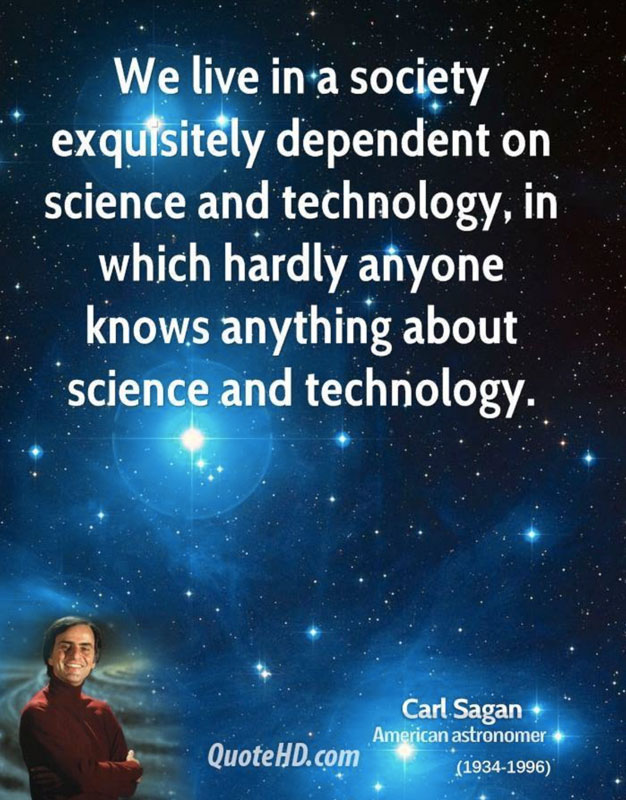 Nous vivons dans une société extrêmement dépendante de la science et de la technologie, dans laquelle presque personne ne comprend la science et de la technologie. |
| "It is better to aim for perfection and miss it than to aim for mediocrity and reach it." Francis Blanche |
 |
I’m fully aware that my letters were far lousy in the beginning. I’m a numbers guy, not a words guy! And, well, I wasn’t the best typist on my second-hand Remington. Don’t worry, over time I get much better and I become a decent journalist, combining my pen with my pictures. I am particularly proud of my article on Haiti (page 23), my description of my work on cruise liners (page 19, at the end) and my report on my ruin, written on the verge of suicide (page 41, at the end). |
 Raphaël Christian Fournier at the residence of M et Mme Courcelle, 22 rue Charles Dubois 80 000 Amiens, February 23 1975. First, « See you Soon » doesn’t necessarily mean within 20 days. I don’t have a lawyer. I hope you’re doing well… in health, in your studies, emotionally, and all those other things you need to do “well”. Thank you for your letter, it’s true I haven’t got much free time, I have too much on the go and it’s wearing me down (math, Beaux-Arts, English, Photo club organizer, 10 hours of math tutoring per week to eke out a living, it doesn’t sound like a lot but it is, skating, etc. etc. It all eats up quite a lot of my time. I still manage to somehow mess up my sensitive paper with my photo boxes. I’ve just successfully written my exam for the unit on topology and less successfully the one for algebra. Why am I in Amiens? For the coffee machine. It is a magnificent machine: SILENCE, precision, efficiency, a part in an erotic slot. A part rings, a button pressed, a soft hum, and it’s ready. It was love at first sight, blinding love at first sight, I signed up without hesitation. You might be thinking that the lid has flipped on this coffee machine, but that’s only because you haven’t got a sentimental coffee machine that doesn’t want to suffer anymore and who knows that it’ll suffer if it gets too attached. And how are things with you? Where do you live? What are you doing? I am going back to work with the National Trust in the forest for 15 days at Easter in Britain. I’ve enclosed a photo of my specter seen through a window in Brighton. Your friend, Raphaël Christian Fournier |
 Here I meet Angelo Falcone, second from the right. |
 And Christian Parramon. |
Who I met again over the years. Here in 2014 in Fontainebleau. In the background, Frédérique Gosky  |
|
 My art work: Leaves in a stream in Peak District, UK. As ever my photos, more or less abstract. Here, some dead leaves at the bottom of a creek. ART. |
At the university in Amiens I met Michère Giry, of whom I haven’t a single photo (yes, it does happen!). She could have been the French Joan Baez, but, contrary to me, she chose to go for her Agrégation (competitive exam allowing you to teach at the secondary and post-secondary level in France) and became a teacher… |
 |
 |
Poem (in case it wasn’t obvious) by Christian Fournier. Sad that the main joke doesn’t translate well! “Problème à poil” means “Hair problem” but also “Naked problem” If you were wondering, the answer to the question is yes. |
 |
 If you are born in Israel, you are probably Jewish. If you are born in Saudi Arabia, you are probably Muslim. If you are born in India, you are probably Hindu. If you are born in North America, you are probably Christian. Your faith is not inspired by a divine truth, it's just geography. |
Patriotism is your belief that this country is superior to all others, because you were born there. |
  |
 In order to understand the universe, you must know the language in which it is written and that language in mathematics.  Je ne garde pas ce que je pêche. J'enfonce un hameçon dans son visage, je l'extirpe de l'eau, j'arrache l'hameçon, et je le rejette, le laissant se demander pourquoi Dieu autorise une telle chose. |
The imposture of science education in French high schools, by Bertrand Rungaldier Posted on June 25, 2013 Depuis leur invention il y a environ 2500 ans, les mathématiques passent pour la discipline de déduction par excellence. Si Platon avait inscrit au fronton de l'Académie "Nul n'entre ici s'il n'est géomètre" ce n'était pas parce qu'il exigeait de savoir faire des constructions compliquées à la règle et au compas mais bien parce qu'il demandait à ses élèves de savoir mener un raisonnement et d'avoir un esprit critique envers leurs propres affirmations. Si 2000 ans plus tard Pascal louait "l'esprit de finesse et de géométrie" c'était pour la même raison : acquérir de la méthode, savoir analyser un problème, savoir le scinder en problèmes plus petits, les résoudre rigoureusement, faire la synthèse du tout. Et ce n'est pas un hasard si à la même époque, Descartes inventait la géométrie analytique dans un essai intitulé "Règles pour la direction de l'esprit" et non un traité de géométrie ou de mathématiques. Partout, en Grèce ou en France, toujours, dans l'antiquité ou à l'époque moderne, les mathématiques ont constitué la discipline de référence en matière de raisonnement. Il est évident que cette façon de procéder, cette démarche intellectuelle que nous nommons désormais "scientifique" peut s'appliquer à n'importe quelle discipline intellectuelle; l'immense avantage des mathématiques est qu'il est extrêmement facile de savoir si l'on a bien conduit son raisonnement ou si l'on a correctement effectué son calcul tout simplement parce que chaque étape dudit raisonnement est clairement identifiée. Il est infiniment plus simple de savoir si l'on a correctement effectué un calcul ou si l'on a effectivement prouvé tel théorème que de savoir si l'on a correctement traduit un sonnet de Shakespeare, un poème de Goethe ou une page des Frères Karamazov. Les Mathématiques ont pour fonction de former à l'art du raisonnement et à la méthode scientifique. C'est là leur essence et c'est ce qui les distingue de l'art du calcul pratiqué par les Egyptiens ou les babyloniens. Il apparaît malheureusement que cette fonction primordiale ait été totalement oubliée par les rédacteurs des récents et actuels programmes d'enseignements des Mathématiques en lycée. On peut même se demander dans quelle mesure ils n'ont pas tout simplement décidé que désormais les Mathématiques ne devaient plus former à la rigueur et au raisonnement tant les programmes de lycée ont été véritablement exterminés au cours de ces dernières années. |
 |
 Diana Frances Spencer, née le 1ᵉʳ juillet 1961 à Sandringham et morte le 31 août 1997 à Paris, est une aristocrate anglaise, membre de la famille royale britannique. Elle épouse en 1981 Charles, prince de Galles, avec qui elle a deux enfants : William, en 1982, et Henry, en 1984  |
| Sur mes cahiers d’écolier Sur mon pupitre et les arbres Sur le sable de neige J’écris ton nom Sur toutes les pages lues Sur toutes les pages blanches Pierre sang papier ou cendre J’écris ton nom Sur les images dorées Sur les armes des guerriers Sur la couronne des rois J’écris ton nom Sur la jungle et le désert Sur les nids sur les genêts Sur l’écho de mon enfance J’écris ton nom Sur les merveilles des nuits Sur le pain blanc des journées Sur les saisons fiancées J’écris ton nom ........ Sur mes refuges détruits ... Et par le pouvoir d’un mot Je recommence ma vie Je suis né pour te connaître Pour te nommer Liberté Paul Eluard, Poésies et vérités, 1942 |
My favorite scientists I photographed 10 great scientists
1 - Christian Deduve, prix Nobel de médecine 2 - Pr Thaisa, Storchi Bergmann, chercheuse en astrophysique 3 - Claude Allègre, géochimiste, prix Crafoord et médaillé du CNRS 4 - Christian Chabrol, a réalisé la première greffe cardiaque en Europe 5 - Robert Clark, National Geographic photographer 6 - Hubert Reeves, chercheur en astrophysique 7 - Thomas Pesquet, spationaute ISS 8 - Claudie Haignère, spationaute Soyouz 9 - Pierre-Gilles de Gennes, prix Nobel de physique 10 - Michel Cymes, médecin français, chirurgien connu pour ses activités d'animateur de télévision et de radio Il manque le Dr Jean-Louis Étienne, voir plus bas My super-heros :  1927 Solvay Congress Conference on Electrons and Photons Congrès Solvay sur les Electrons et Photons, à l'Institut international de physique Solvay dans le parc Léopold à Bruxelles. (Dix-sept des vingt-neuf personnalités présentes sont lauréates d'un prix Nobel.) Rangée à l'arrière / back : Auguste Piccard, Émile Henriot, Paul Ehrenfest, Édouard Herzen, Théophile de Donder, Erwin Schrödinger, Jules-Émile Verschaffelt, Wolfgang Pauli, Werner Heisenberg, Ralph H. Fowler, Léon Brillouin; Rangée du milieu / middle : Peter Debye, Martin Knudsen, William Lawrence Bragg, Hendrik Anthony Kramers, Paul Dirac, Arthur Compton, Louis de Broglie, Max Born, Niels Bohr; Rangée à l'avant / front : Irving Langmuir, Max Planck, Marie Curie, Hendrik Lorentz, Albert Einstein, Paul Langevin, Charles-Eugène Guye, Charles Thomson Rees Wilson, Owen Willans Richardson. Carl Sagan 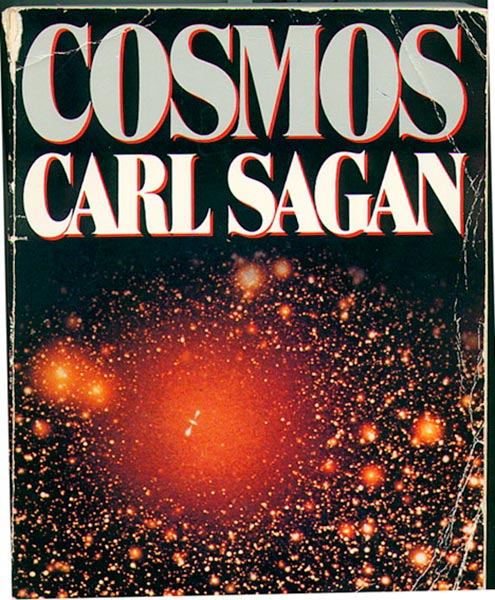  Carl Sagan (1934 – 1996) est un scientifique et astronome américain. Il est l'un des fondateurs de l'exobiologie. Il a mis en place le programme SETI de recherche d'intelligence extraterrestre. Il est aussi renommé pour son scepticisme. Carl Sagan était professeur et directeur de laboratoire à l'Université Cornell et a contribué à la plupart des missions automatiques d'exploration spatiale du système solaire. Il est également connu pour avoir coécrit un article annonçant les dangers de l'hiver nucléaire. Pendant la première guerre du Golfe, Sagan a prédit que la fumée engendrée par les bombardements américains des puits et raffineries de pétrole irakiens entraînerait des conséquences proches de l'hiver nucléaire. Sagan est surtout connu du grand public pour ses œuvres de vulgarisation scientifique. Il a écrit et raconté la série télévisée Cosmos (treize épisodes vus par 10 millions de téléspectateurs) dans laquelle il développe, entre autres, un calendrier cosmique. Celui-ci sera souvent repris par la suite dans plusieurs livres et documentaires de vulgarisation de l'astronomie. Sagan fut l'un des pères fondateurs d'un des groupes sceptiques américains, le Committee for Skeptical Inquiry, qui considère qu'aucune preuve de l'existence du paranormal n'a été apportée à ce jour. Son ouvrage The Demon-Haunted World est considéré comme un classique du scepticisme scientifique. Le plus incroyable, c'est qu'il soit complétement inconnu en France, bien qu'ayant quasiment sauvé la planète d'une guerre nucléaire en rencontrant Ronald Regan et Gorbatchev à l'époque de la guerre froide et l'accumulation inconsidérée de bombes atomiques dans chaque camp et leur expliquant qu'ils étaient comme deux guerriers dans un garage inondé d'essence et se menaçant chacun avec une boîte d'allumettes. En prenant l’avion de Los Angeles à Paris, quand je suis retourné en France en 1992, j’ai vécu le même phénomène de science-fiction que dans le film "Yesterday" ou tout d’un coup les Beatles n'ont jamais existés, avec le scientifique Carl Sagan. En France il n'avait jamais existé ! (De « Le monde hanté par les démons: la science comme une bougie dans le noir (Edition anglaise) » par Carl Sagan en 1995) The Sphinx, half human, half lion, was constructed more than 5,500 years ago. Its face was once crisp and cleanly rendered. It is now softened and blurred by thousands of years of Egyptian desert sandblasting and by occasional rains. In New York City there is an obelisk called Cleopatra's Needle, which came from Egypt. In only about a hundred years in that city's Central Park, its inscriptions have been almost totally obliterated, because of smog and industrial pollution—chemical erosion like that in the atmosphere of Venus. Erosion on Earth slowly wipes out information, but because they are gradual—the patter of a raindrop, the sting of a sand grain—those processes can be missed. Big structures, such as mountain ranges, survive tens of millions of years; smaller impact craters, perhaps a hundred thousand; and largescale human artifacts only some thousands. In addition to such slow and uniform erosion, destruction also occurs through catastrophes large and small. The Sphinx is missing a nose. Someone shot it off in a moment of idle desecration—some say it was Mameluke Turks, others, Napoleonic soldiers. On Venus, on Earth and elsewhere in the solar system, there is evidence for catastrophic destruction, tempered or overwhelmed by slower, more uniform processes: on the Earth, for example, rainfall, coursing into rivulets, streams and rivers of running water, creating huge alluvial basins; on Mars, the remnants of ancient rivers, perhaps arising from beneath the ground; on Io, a moon of Jupiter, what seem to be broad channels made by flowing liquid sulfur. There are mighty weather systems on the Earth—and in the high atmosphere of Venus and on Jupiter. There are sandstorms on the Earth and on Mars; lightning on Jupiter and Venus and Earth. Volcanoes inject debris into the atmospheres of the Earth and Io. Internal geological processes slowly deform the surfaces of Venus, Mars, Ganymede and Europa, as well as Earth. Glaciers, proverbial for their slowness, produce major reworkings of landscapes on the Earth and probably also on Mars. These processes need not be constant in time. Most of Europe was once covered with ice. A few million years ago, the present site of the city of Chicago was buried under three kilometers of frost. On Mars, and elsewhere in the solar system, we see features that could not be produced today, landscapes carved hundreds of millions or billions of years ago when the planetary climate was probably very different. There is an additional factor that can alter the landscape and the climate of Earth: intelligent life, able to make major environmental changes. Like Venus, the Earth also has a greenhouse effect due to its carbon dioxide and water vapor. The global temperature of the Earth would be below the freezing point of water if not for the greenhouse effect. It keeps the oceans liquid and life possible. A little greenhouse is a good thing. Like Venus, the Earth also has about 90 atmospheres of carbon dioxide; but it resides in the crust as limestone and other carbonates, not in the atmosphere. If the Earth were moved only a little closer to the Sun, the temperature would increase slightly. This would drive some of the CO2 out of the surface rocks, generating a stronger greenhouse effect, which would in turn incrementally heat the surface further. A hotter surface would vaporize still more carbonates into CO2, and there would be the possibility of a runaway greenhouse effect to very high temperatures. This is just what we think happened in the early history of Venus, because of Venus' proximity to the Sun. The surface environment of Venus is a warning: something disastrous can happen to a planet rather like our own. The principal energy sources of our present industrial civilization are the so-called fossil fuels. We burn wood and oil, coal and natural gas, and, in the process, release waste gases, principally CO2, into the air. Consequently, the carbon dioxide content of the Earth's atmosphere is increasing dramatically. The possibility of a runaway greenhouse effect suggests that we have to be careful: Even a one- or two- degree rise in the global temperature can have catastrophic consequences. In the burning of coal and oil and gasoline, we are also putting sulfuric acid into the atmosphere. Like Venus, our stratosphere even now has a substantial mist of tiny sulfuric acid droplets. Our major cities are polluted with noxious molecules. We do not understand the long- term effects of our course of action. But we have also been perturbing the climate in the opposite sense. For hundreds of thousands of years human beings have been burning and cutting down forests and encouraging domestic animals to graze on and destroy grasslands. Slash-and-burn agriculture, industrial tropical deforestation and overgrazing are rampant today. But forests are darker than grasslands, and grasslands are darker than deserts. As a consequence, the amount of sunlight that is absorbed by the ground has been declining, and by changes in the land use we are lowering the surface temperature of our planet. Might this cooling increase the size of the polar ice cap, which, because it is bright, will reflect still more sunlight from the Earth, further cooling the planet, driving a runaway albedo (1) effect? Our lovely blue planet, the Earth, is the only home we know. Venus is too hot. Mars is too cold. But the Earth is just right, a heaven for humans. After all, we evolved here. But our congenial climate may be unstable. We are perturbing our poor planet in serious and contradictory ways. Is there any danger of driving the environment of the Earth toward the planetary Hell of Venus or the global ice age of Mars? The simple answer is that nobody knows. The study of the global climate, the comparison of the Earth with other worlds, are subjects in their earliest stages of development. They are fields that are poorly and grudgingly funded. In our ignorance, we continue to push and pull, to pollute the atmosphere and brighten the land, oblivious of the fact that the long-term consequences are largely unknown. A few million years ago, when human beings first evolved on Earth, it was already a middle-aged world, 4.6 billion years along from the catastrophes and impetuosities of its youth. But we humans now represent a new and perhaps decisive factor. Our intelligence and our technology have given us the power to affect the climate. How will we use this power? Are we willing to tolerate ignorance and complacency in matters that affect the entire human family? Do we value short-term advantages above the welfare of the Earth? Or will we think on longer time scales, with concern for our children and our grandchildren, to understand and protect the complex life-support systems of our planet? The Earth is a tiny and fragile world. It needs to be cherished. 1. The albedo is the fraction of the sunlight striking a planet that is reflected back to space. The albedo of the Earth is some 30 to 35 percent. The rest of the sunlight is absorbed by the ground and is responsible for the average surface temperature. Copyright © 1980 by Carl Sagan Productions, Inc. Excerpted by permission of Ballantine Books, a division of Random House LLC. All rights reserved. No part of this excerpt may be reproduced or reprinted without permission in writing from the publisher. « Right now the doubling time of the world population is about 40 years. Every 40 years there will be twice as many of us. As the English clergyman Thomas Malthus pointed out in 1798, a population increasing exponentially—Malthus described it as a geometrical progression—will outstrip any conceivable increase in food supply. No Green Revolution, no hydroponics, no making the deserts bloom can beat an exponential population growth. » (de « Billions & Billions: Thoughts on Life and Death at the Brink of the Millennium » par Carl Sagan) Circa 1985 « Today, the United States and the Soviet Union have booby-trapped our planet with almost 60,000 nuclear weapons. Sixty thousand nuclear weapons! Even a small fraction of the strategic arsenals could without question annihilate the two contending superpowers, probably destroy the global civilization, and possibly render the human species extinct. No nation, no man should have such power. We distribute these instruments of apocalypse all over our fragile world, and justify it on the grounds that it has made us safe. We have made a fool’s bargain. » (de « Billions & Billions: Thoughts on Life and Death at the Brink of the Millennium » par Carl Sagan)    "The warming up of our planet is a chain reaction: heat generated by humans create CO2 which rises in the atmosphere. The CO2 in the atmosphere then warms the planet like a coat which makes the CO2 rise in the atmosphere, and warms up the planet, and so on. Carl Sagan* warned us in 1985. He calculated that if humans do not act on it immediately (1985), due the chain reaction, in 30 years time (2015), it will be too late to reverse the reaction. When the young people of today (2023) in France demonstrate for their retirement at 60, or 62 or 64, they are wrong: since nobody cares about global warming, the world will already be unlivable by then." Christian Fournier. Carl Sagan, great astronomer, science popularizer and science fiction writer, one of the greatest of the 20th century, passed away on December 20, 1996, at the age of only 62. On it veryone you love, everyone you know, everyone you ever heard of, every human being who ever was, lived out their lives. Charles Darwin  ou plus simple, mais très fort : Ce qui survit, survit. « “Darwin’s theory of evolution is extremely well established, because it is based on scientifically observable fact, and clearly illustrates how organisms evolve and adapt to their environments over time. The theory of evolution is universally accepted by the sharpest minds in science.” » (de « Origin: (Robert Langdon Book 5) » par Dan Brown) Copernic "Earth is not the center of the world" 
Nicolas Copernic est un chanoine, médecin et astronome polonais. Il est célèbre pour avoir développé et défendu la théorie de l'héliocentrisme selon laquelle le Soleil se trouve au centre de l'Univers et la Terre tourne autour de lui contre la croyance répandue que cette dernière était centrale et immobile. Les conséquences de cette théorie dans le changement profond des points de vue scientifique, philosophique et religieux qu'elle impose sont baptisées révolution copernicienne. Copernic publia le résultat de ses travaux en 1543 dans De Revolutionibus (Des révolutions). Dans cet ouvrage, le Soleil occupait le centre du monde et c’est autour de lui que les autres corps tournaient, avec dans l’ordre, Mercure, Vénus, la Terre, Mars, Jupiter et Saturne. Daniel Bernoulli est un médecin, physicien et mathématicien suisse, né à Groningue le 8 février 1700, et mort à Bâle, le 17 mars 1782.   Le théorème de Bernoulli, qui a été établi en 1738 par Daniel Bernoulli, stipule que la vitesse d’un fluide (l’air, dans ce cas), détermine la quantité de pression qu’un fluide peut exercer. Il explique la poussée, l'une des quatre forces de vol et de voile. L'air en mouvement est séparé en deux flux lorsqu'il rencontre une aile (avion ou voile). La partie supérieure a un chemin plus long à parcourir. Cela réduit sa vitesse et crée une basse pression. Thalès Thalès de Milet, appelé communément Thalès (en grec ancien : Θαλῆς ὁ Μιλήσιος / Thalễs ho Milếsios), est un philosophe et savant grec né à Milet vers -625 et mort vers -547 dans cette même ville. C'est l'un des Sept sages de la Grèce antique et le fondateur présumé de l'école milésienne. Philosophe de la nature, il passe pour avoir effectué un séjour en Égypte, où il aurait été initié aux sciences égyptienne et babylonienne. On lui attribue de nombreux exploits, comme le calcul de la hauteur de la grande pyramide ou la prédiction d'une éclipse, ainsi que le théorème de Thalès. Il fut l'auteur de nombreuses recherches mathématiques, notamment en géométrie. Personnage légendaire, qui semble n'avoir rien écrit, sa méthode d'analyse du réel en fait l'une des figures majeures du raisonnement scientifique. Il sut s'écarter des discours explicatifs délivrés par la mythologie pour privilégier une approche caractérisée par l'observation et la démonstration. AP/PD = CB/BD => AP x PD / BD « The opening words of Albert Einstein’s 1905 paper are characteristic of the scientific report. It is refreshingly unself-serving, circumspect, understated. Contrast its restrained tone with, say, the products of modern advertising, political speeches, authoritative theological pronouncements. » (de « The Demon-Haunted World: Science as a Candle in the Dark » par Carl Sagan) Marie Curie et Pierre Curie — son époux — reçoivent une moitié du prix Nobel de physique de 1903 (l'autre moitié est remise à Henri Becquerel) pour leurs recherches sur les radiations. En 1911, elle obtient le prix Nobel de chimie pour ses travaux sur le polonium et le radium. Scientifique d'exception, elle est la première femme à avoir reçu le prix Nobel, et à ce jour la seule femme à en avoir reçu deux. Elle reste à ce jour la seule personne à avoir été récompensée dans deux domaines scientifiques distincts (par la suite, et en dehors strictement des sciences, Linus Pauling obtint le prix Nobel de chimie en 1954 et le prix Nobel de la paix en 1962). Elle est également la première femme lauréate en 1903, avec son mari, de la médaille Davy pour ses travaux sur le radium2. Une partie de ses cahiers d'expérience sont conservés à la Bibliothèque nationale de France et ont été numérisés. Visite du musée Curie le 19 février 2022 Situé dans le dernier laboratoire dirigé par Marie Curie, le Musée Curie allie nouvelles technologies, documents d'archive et objets anciens dans un espace de 120 m2, rénové en 2012. Vous y découvrirez le bureau et le laboratoire de Marie Curie, l'histoire de la radioactivité et de la radiothérapie, ainsi que les différentes étapes des découvertes scientifiques des Curie et des Joliot-Curie, la famille aux cinq prix Nobel. L'Institut du Radium, dont la construction débuta en 1911, comprenait un laboratoire de physique et de chimie dirigé par Marie Curie et un laboratoire de médecine et de biologie confié au docteur Claudius Regaud. Au rez-de-chaussée du pavillon Curie de l'ancien Institut du Radium, le musée Curie présente des objets, des photographies et des documents sur l'histoire de la radioactivité et de ses applications médicales, ainsi que sur la vie et l'oeuvre de "la famille aux cinq prix Nobel". De nombreux instruments scientifiques utilisés jusqu'à la fin des années 1930 sont exposés, en particulier ceux qui ont permis de produire artificiellement, pour la première fois au monde, des radioéléments. C'est dans ce lieu en effet qu'en janvier 1934, Frédéric et Irène Joliot-Curie découvrirent la radioactivité artificielle. On peut voir l'ancien bureau de Marie Curie, de même que son laboratoire de chimie (décontaminé en 1981). Le musée Curie, rénové en 2012, propose un parcours muséographique aménagé selon 4 thématiques : la famille aux cinq prix Nobel ; le radium ; le laboratoire Curie ; la Fondation Curie pour soigner les cancers. Le radium est un élément de la famille des alcalino-terreux. Il en existe 25 isotopes mais seuls quatre sont présents dans la nature. Parmi eux, le plus abondant est le 226Ra qui se caractérise par une période de 1600 ans environ.      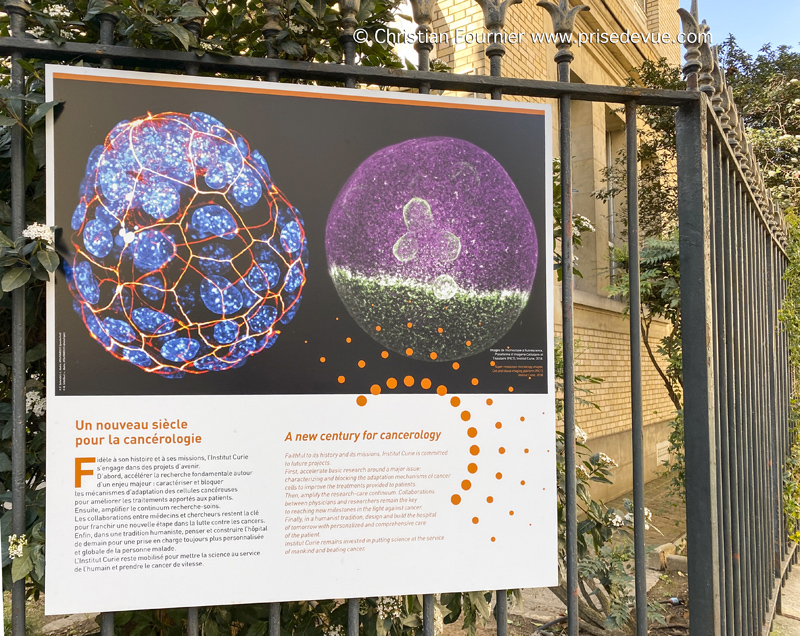  J'habite à côté.  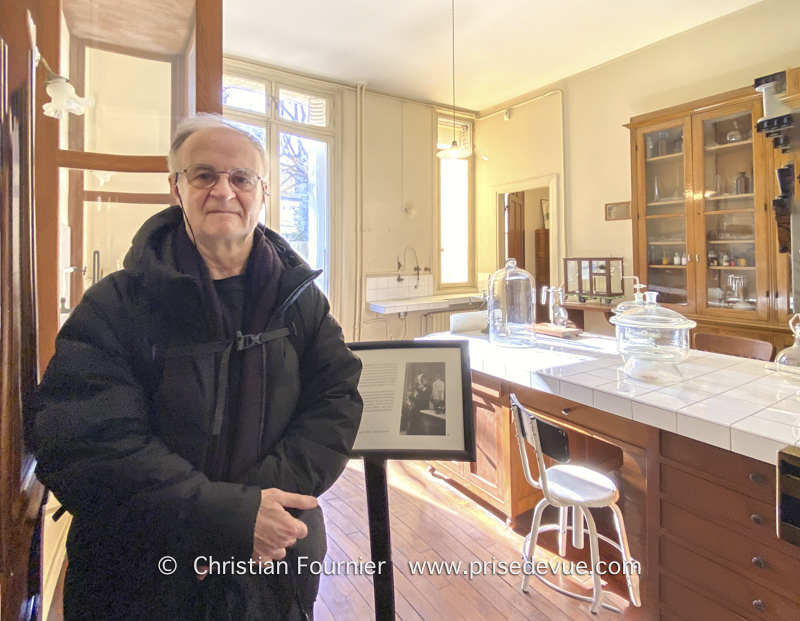  Shannon Templeton, astronomer at NASA for TESS La soucoupe volante est un lampadaire éteint Those are gorgeous pictures of the Moon, I love how you included the night version of the "UFO" and then the day version showing it is a lamp. That is wonderful!
I have stopped using Facebook, it was taking up too much of my time. I also think it is a little bit awful and actively screwed up the elections for the US helping put Trump in office. But it does have its good side, such as getting to see your pictures, and I really miss that. So I may start using it again, who knows? I am so happy you emailed me when you didn't see me on Facebook. Thank you for doing that! I am involved with a very exciting project now which is taking up my time - NASA's TESS planet hunter space telescope. The observatory I work with got accepted into their "follow up" program which means I'm part of the group of astronomers who get to see the data first. The TESS cameras have huge pixels that can have more than one star in each pixel, so when an exoplanet crosses in front of its star (from our point of view), there is a small dip in the light. The TESS cameras will detect the small dimming which triggers an alert that there may be an exoplanet somewhere in the sky area covered by the huge pixel. We get a list of those coordinates in the sky and then it's our job to follow up using our ground based telescope to see which star is dimming in brightness. I hope I have explained it well, it is so exciting to be involved with this work! What could be more fun than finding planets outside our solar system? This gives a good overview of what TESS does: https://www.nasa.gov/content/about-tess The Transiting Exoplanet Survey Satellite (TESS) is the next step in the search for planets outside of our solar system, including those that could support life. The mission will find exoplanets that periodically block part of the light from their host stars, events called transits. TESS will survey 200,000 of the brightest stars near the sun to search for transiting exoplanets. TESS launched on April 18, 2018, aboard a SpaceX Falcon 9 rocket. TESS scientists expect the mission will catalog thousands of planet candidates and vastly increase the current number of known exoplanets. Of these, approximately 300 are expected to be Earth-sized and super-Earth-sized exoplanets, which are worlds no larger than twice the size of Earth. TESS will find the most promising exoplanets orbiting our nearest and brightest stars, giving future researchers a rich set of new targets for more comprehensive follow-up studies. And here is more about the Follow Up program if you want to see examples of the data. I know you would love the math. https://heasarc.gsfc.nasa.gov/docs/tess/followup.html I hope you are doing well, it is always wonderful to hear from you. Shannon    Students should be made to think, communicate, question, learn from their mistakes, and, most importantly, have fun in their learning. "I'd rather have questions that can't be answered than answers that can't be questioned." "The imagination of nature is far, far greater than the imagination of man" Richard Feynman  Surely you're joking Mr. Feynman "Surely You're Joking, Mr. Feynman!": Adventures of a Curious Character is an edited collection of reminiscences by the Nobel Prize-winning physicist Richard Feynman. The book, released in 1985, covers a variety of instances in Feynman's life. The anecdotes in the book are based on recorded audio conversations that Feynman had with his close friend and drumming partner Ralph Leighton. Richard Feynman (May 11, 1918 – February 15, 1988) was an American theoretical physicist,   Le 28 juin 2009, Stephen Hawking annonce une party pour les voyageurs du temps. Il a annoncé sa soirée le lendemain 29 juin 2009, après coup, et a déclaré que personne n'était venu. « The Earth is under threat from so many areas that it is difficult for me to be positive. The threats are too big and too numerous. First, the Earth is becoming too small for us. Our physical resources are being drained at an alarming rate. We have presented our planet with the disastrous gift of climate change. Rising temperatures, reduction of the polar ice caps, deforestation, over-population, disease, war, famine, lack of water and decimation of animal species; these are all solvable but so far have not been solved. » (de « Brief Answers to the Big Questions: the final book from Stephen Hawking (English Edition) » par Stephen Hawking) « At the same time, many of those same politicians are denying the reality of man-made climate change, or at least the ability of man to reverse it, just at the moment that our world is facing a series of critical environmental crises. The danger is that global warming may become self-sustaining, if it has not become so already. The melting of the Arctic and Antarctic ice caps reduces the fraction of solar energy reflected back into space, and so increases the temperature further. Climate change may kill off the Amazon and other rainforests and so eliminate one of the main ways in which carbon dioxide is removed from the atmosphere. The rise in sea temperature may trigger the release of large quantities of carbon dioxide. Both these phenomena would increase the greenhouse effect, and so exacerbate global warming. Both effects could make our climate like that of Venus: boiling hot and raining sulphuric acid, but with a temperature of 250 degrees Celsius. Human life would be unsustainable. We need to go beyond the Kyoto Protocol, the international agreement adopted in 1997, and cut carbon emissions now. We have the technology. We just need the political will. » (de « Brief Answers to the Big Questions: the final book from Stephen Hawking (English Edition) » par Stephen Hawking) « An asteroid collision would be something against which we have no defence. The last big such collision with us was about sixty-six million years ago and that is thought to have killed the dinosaurs, and it will happen again. This is not science fiction; it is guaranteed by the laws of physics and probability. » (de « Brief Answers to the Big Questions: the final book from Stephen Hawking (English Edition) » par Stephen Hawking) « Nuclear war is still probably the greatest threat to humanity at the present time. It is a danger we have rather forgotten. Russia and the United States are no longer so trigger-happy, but suppose there’s an accident, or terrorists get hold of the weapons these countries still have. And the risk increases the more countries obtain nuclear weapons. Even after the end of the Cold War, there are still enough nuclear weapons stockpiled to kill us all, several times over, and new nuclear nations will add to the instability. With time, the nuclear threat may decrease, but other threats will develop, so we must remain on our guard. » (de « Brief Answers to the Big Questions: the final book from Stephen Hawking (English Edition) » par Stephen Hawking) « What is the biggest threat to the future of this planet? An asteroid collision would be – a threat against which we have no defence. But the last big such asteroid collision was about sixty-six million years ago and killed the dinosaurs. A more immediate danger is runaway climate change. A rise in ocean temperature would melt the ice caps and cause the release of large amounts of carbon dioxide. Both effects could make our climate like that of Venus, but with a temperature of 250 degrees Celsius. » (de « Brief Answers to the Big Questions: the final book from Stephen Hawking (English Edition) » par Stephen Hawking)  Neil deGrasse Tyson : "Si vous pensez que l'éducation coûte cher, essayer le prix de l'ignorance." Neil deGrasse Tyson est un astrophysicien américain né le 5 octobre 1958 à New York. Depuis 1996, il est directeur du planétarium Hayden à l'American Museum of Natural History de New York. C'est un des scientifiques américains les plus populaires, souvent considéré comme l'héritier de Carl Sagan. Depuis 2006, il présente l'émission NOVA scienceNOW sur PBS.  « There are of order 100 billion galaxies in the observable universe. Each of these barely resolved dots of light is a full galaxy, as large as the Milky Way, containing more than 100 billion stars. » (de « Welcome to the Universe: An Astrophysical Tour » par Neil deGrasse Tyson, Michael A. Strauss, J. Richard Gott) Quand mon livre "Émotions sous-marines est sorti, en 1996, j'ai dû faire des séances de dédicaces. Une fois, au musée de l'homme, j'étais assis à côté d'un autre auteur, Dr Jean-Louis Étienne. Il a eu plus de succès que moi, avec son livre "le marcheur du pôle." J'ai revu Jean-Louis le 19 septembre 2019, lors d'une réunion Sogaris.  Jean-Louis Étienne, né le 9 décembre 1946 à Vielmur-sur-Agout dans le Tarn, est un médecin et explorateur français. Il est connu pour ses expéditions en Arctique, il a été le premier homme à atteindre le pôle Nord en solitaire en 1986, et en Antarctique, notamment la Transantarctica réalisée en 1989-1990. Le 14 mai 1986, il est le premier homme à atteindre le pôle Nord en tirant lui-même son traîneau pendant 63 jours avec des ravitaillements. À cette époque le GPS et le téléphone Iridium n'existaient pas. Il s'est dirigé grâce au soleil et sa position était suivie par le Centre national d'études spatiales grâce à une balise Argos qui a confirmé son arrivée sur l'axe de rotation de la Terre, 89°993 N. En 1989-90, il est co-leader avec l'Américain Will Steger de l'expédition internationale Transantarctica, la plus longue traversée de l'Antarctique à traîneau à chien, à laquelle ont pris part un Russe, un Chinois, un Japonais et un Anglais. Partis de l'extrémité de la Péninsule Antarctique le 25 juillet 1989, ils atteignent la base russe Mirny via le pôle Sud, 6 300 km, sept mois d'expédition. 1991-1996 : à bord de la goélette Antarctica (actuellement le Tara), il mène des expéditions scientifiques en Antarctique, au volcan Erebus puis un hivernage au Spitzberg pour préparer la dérive à travers l'océan Arctique. Avril 2002-juillet 2002 : la Mission Banquise à bord du Polar Observer en dérive pendant trois mois au pôle Nord pour étudier le réchauffement climatique. Janvier-avril 2005 : Expédition Clipperton sur l'île de Clipperton dans l'océan Pacifique pour établir un inventaire de la biodiversité de l'atoll français au large des côtes du Mexique, et par là même affirmer la souveraineté française sur l'île. Avril 2007-mars 2008 : Total Pole Airship, une mission scientifique de mesure de l'épaisseur de la banquise de l'océan Arctique en dirigeable, via le pôle Nord géographique, dans le cadre de l'année polaire internationale. Le 22 janvier 2008, l'accident du dirigeable qui avait rompu ses amarres à la suite de fortes rafales de vent, contraint Jean-Louis Étienne à annoncer que l'expédition ne pourrait avoir lieu. Avril 2010 : première traversée de l'océan Arctique en ballon rozière. Le décollage a lieu le 5 avril 2010 du Spitzberg, Jean-Louis Étienne se pose en Sibérie orientale après un vol en solitaire de 5 j 2 h 15 min et une distance parcourue de 3 160 km. Projet : Polar Pod Expédition, une exploration de l'océan Austral, une immense étendue d'eau encore méconnue qui entoure le continent Antarctique. Il est considéré aujourd'hui comme le principal puits de carbone de la planète. Cette campagne se fera à bord du Polar Pod, une plateforme océanographique conçue pour dériver dans le Courant Circumpolaire Antarctique. D'après les simulations de Météo France et Mercator Océan, cette circumnavigation devrait durer trois ans. Propulsé par le courant et alimenté en énergie renouvelable, il s'agit de la première campagne océanographique « zéro émission ». 20 sept. 2017 - FUTURA PLANETE : Pensez-vous que ces violentes intempéries améliorent la prise de conscience du réchauffement climatique ? - Jean-Louis Étienne : À Saint-Martin et Saint-Barthélemy, la conscience est bien là, mais chez nous ? On comprend mieux quand on est touché... Mon espoir est que cela puisse déstabiliser Donald Trump. Il est vrai que ce n'est pas facile d'expliquer le réchauffement climatique. C'est une donnée scientifique, ce n'est pas perceptible. Dire que la température globale s'est élevée de 0,5 ou 1 °C sur telle période, ce n'est pas très parlant. Les conséquences, en revanche, deviennent tangibles. Les scientifiques s'expriment toujours avec beaucoup de prudence, bien sûr. Ce qui peut donner l'impression que, finalement, ils ne savent pas. - FUTURA PLANETE : Doit-on s'attendre à voir davantage de cyclones ? Jean-Louis Étienne : Sans doute, et de plus intenses. Une petite augmentation de température là où ils se forment les rend plus violents. Et n'oublions pas la hausse du niveau de la mer. On en est à 3,2 mm par an. Trois centimètres sur une décennie, c'est énorme. Or, sous une dépression, la mer est soulevée. L'impact sur les côtes est donc très important. Hubert Reeves en 2007  Ayant commencé sa carrière en tant que chercheur en astrophysique, il pratique aussi la vulgarisation scientifique depuis les années 1970 et s'avère aussi un militant écologiste depuis les années 2000. Citations de Hubert Reeves : Nous sommes en train de vivre un anéantissement biologique" Mal adapté parce que trop bien nanti, néfaste à l'équilibre biologique de la planète, l'être humain serait-il en définitive une erreur de la nature ? Une question fondamentale se pose d’une façon de plus en plus pressante : la crise planétaire contemporaine prendra-t-elle fin grâce à l’action déterminée des Terriens ou par leur disparition ? Devenir adulte, c'est apprendre à vivre dans le doute et à développer au travers des expériences, sa propre philosophie, sa propre morale. Les choses sont ce qu'elles sont parce qu'elles étaient ce qu'elles étaient... La question n'est pas de savoir si Dieu existe ou non. Mais plutôt : qui est-il, et à quoi joue-t-il ?
 Christian René Marie Joseph, vicomte de Duve, né le 2 octobre 1917 à Thames-Ditton en Angleterre et mort le 4 mai 2013 à Nethen en Belgique, est un docteur en médecine et biochimiste belge qui reçut le prix Nobel de physiologie ou médecine en 1974. La vie de Christian de Duve, son travail, sa passion ont fait l’objet d’un documentaire réalisé en 2012 par Aurélie Wijnants. Pierre-Gilles de Gennes lors de la cérémonie de remises des prix L'Oréal-  Unesco en 2003 : "Women in Sciences". Pierre-Gilles de Gennes, né le 24 octobre 1932 à Paris et mort le 18 mai 2007 à Orsa, est un physicien français. Il reçut le prix Nobel de physique de 1991 pour ses travaux sur les cristaux liquides et les polymères. Ses contributions ont inspiré et généré de très nombreuses études relevant tant de la physique et de la physico-chimie fondamentales que des sciences appliquées. Michel Cymes, médecin français, chirurgien spécialisé dans l'ORL, connu pour ses activités d'animateur de télévision et de radio, notamment pour l'émission Le Magazine de la santé qu'il présente avec Marina Carrère d'Encausse 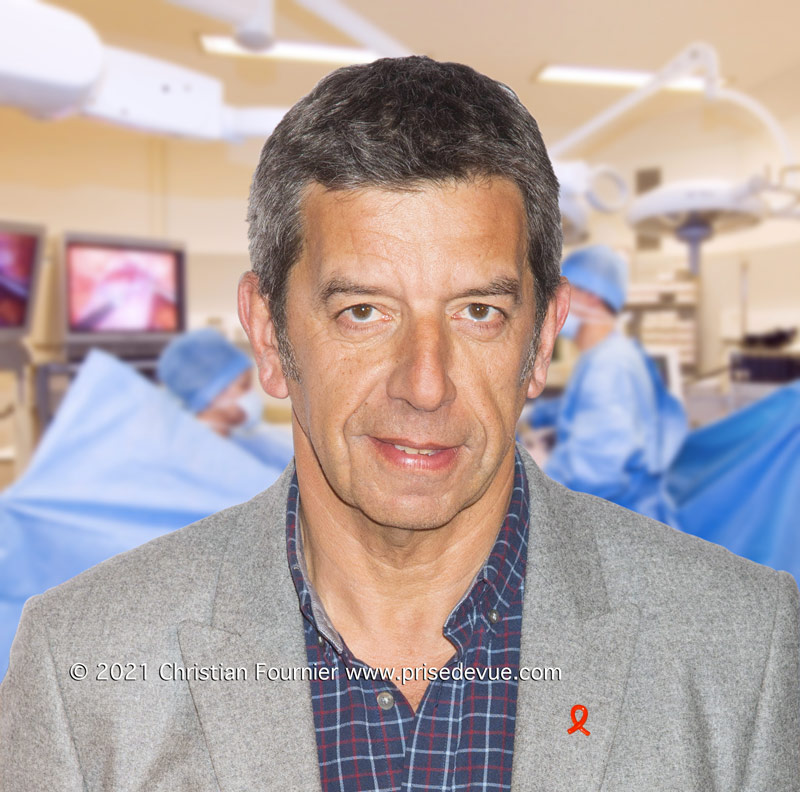 Dr Nicole Bordes  Je tombe amoureux du Dr Nicole Bordes. Doctorat (Ph.D.) INSA Toulouse; Diplôme d'Etudes Approfondies (M.Sc.) INSA Toulouse; Diplôme d'Ingénieur, Institut National des Sciences Appliquées (INSA) Toulouse; CNRS Centre National de la Recherche Scientifique, France, 1983-1987; Los Alamos National Laboratory, USA, 1987-1989; University of New Mexico, USA, 1992-1994; Sydney VisLab, 1994-1996, Nov 1997 till present. Grande, très intelligente, belle, chevelure noire de geais, timide. Nous vivons des aventures extraordinaires. Création des deux célèbres séries photo "The Fun Couple" et "Nicole Tu Me Manques". Depuis, je ne drague plus les passagères! Voir aussi les reportages : Feu à bord de l'Ocean Pearl, Requins bleu de Californie, Cold Plunge, Nias, The studio in the Woods à Vancouver. La série : The fun Couple, bien avant les "Des chiens"    Je suis basé à Torrance, Californie. Je loue un appart (ici dessus) avec Nicole dans un complexe immobilier (piscine, salle de réception, etc...) Tout près de la plage, du downtown LA et Hollywood, du port Long Beach et de l'aéroport LAX, parfait pour un photographe très itinérant. Une photo numérique en 1989 ! Nicole a amélioré notre Apple Mac Plus !  La série "Tu Me Manques"   Définition équation différentielle : En mathématiques, une équation différentielle est une équation dont la ou les inconnues sont des fonctions ; elle se présente sous la forme d'une relation entre ces fonctions inconnues et leurs dérivées successives. Thomas Pesquet 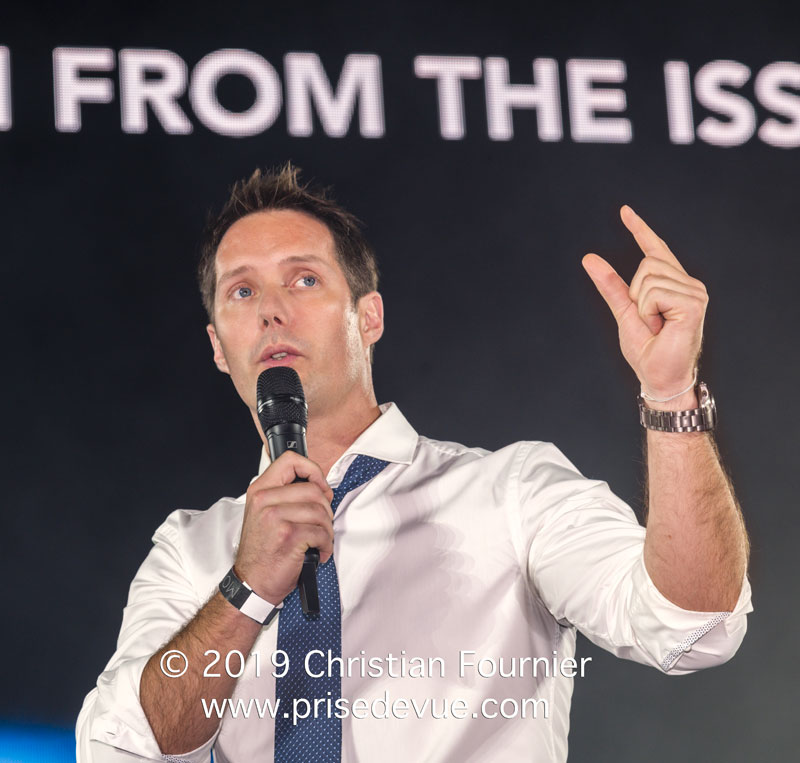 Thomas Pesquet, né le 27 février 1978 à Rouen, est un spationaute français. Après une formation d'ingénieur aéronautique, Thomas Pesquet a occupé différents postes dans l'industrie aérospatiale et au Centre National d'Etudes Spatiales (CNES) avant de devenir, en 2005, pilote de ligne. En 2009, il fait partie des six candidats retenus pour former le troisième groupe d'astronautes européens sélectionnés par l'Agence spatiale européenne (ESA). Thomas Pesquet est le dixième Français à partir dans l'espace en décollant le 17 novembre 2016 à bord de Soyouz MS-03 dont l’équipage occupe la Station spatiale internationale de novembre 2016 à juin 2017. Durant cette mission, Thomas Pesquet a mené une centaine d'expériences dont la moitié développée par l'Agence spatiale européenne ou le CNES, l'autre moitié par la NASA. Il effectue deux sorties extravéhiculaires de six heures pour des missions de maintenance de la Station spatiale internationale.  Thomas, je t'emmène pour ma prochaine mission sur la lune.   Il est bien impossible que la constellation Orion, si petite dans le ciel, puisse se refléter sur les pyramides.  L'excellent film Le Théorème de Marguerite (2023) de Anna Novion présente un personnage de normalienne, Marguerite, qui travaille sur la résolution d’un pan de la conjecture de Goldbach. La conjecture de Goldbach est l'assertion mathématique qui s’énonce comme suit : Tout nombre entier pair supérieur à 3 peut s’écrire comme la somme de deux nombres premiers. Formulée en 1742 par Christian Goldbach, c’est l’un des plus vieux problèmes non résolus de la théorie des nombres et des mathématiques. Il partage avec l'hypothèse de Riemann et la conjecture des nombres premiers jumeaux le numéro 8 des problèmes de Hilbert, énoncés par celui-ci en 1900.  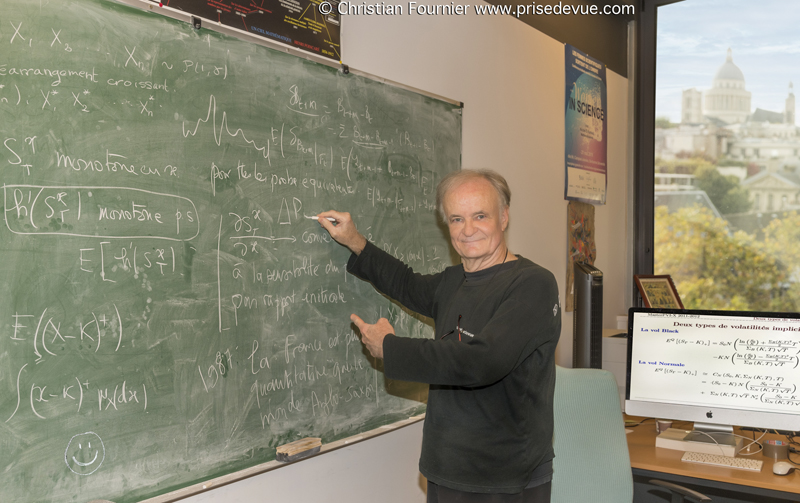 2023 : Comme la photo ça ne paye plus, j’ai repris mon ancien job : prof de Maths. Ici à l’université de Jussieu à Paris le 07 nov 2023. Merci à Nicole EL KAROUI, Professeur Emérite de Mathématiques Appliquées Université Sorbonne-Université (ex UPMC-ParisVI)  Anagyre est le nom donné à un objet paradoxal qui, lancé dans le sens naturel de rotation tourne rapidement, alors que lancé dans le sens opposé, il s'arrête après quelques instants en vibrant, pour repartir dans le sens contraire et naturel de rotation 
« (Les fausses sciences ne m’intéressent nullement, pas plus la théologie ou l’apologétique que l’astrologie, les lignes de la main, les gris-gris, ou la torsion de petites cuillères à distance) » (de « Lettre ouverte aux culs-bénits » par François Cavanna) "De l’autre côté du seuil d’une caserne, la démocratie prend une drôle de gueule." (Les Pensées de Cavanna » par François CAVANNA) "Coups de sang" de François Cavanna Si vraiment c'est un dieu qui a créé ce cloaque d'horreur et de désespoir avec la mort au bout, alors c'est un tel salaud qu'il vaut mieux qu'il n'y en ait pas.
  J'ai eu l'immense plaisir de photographier le 20 janvier 2017 le Concert Te Deum d’Hector Berlioz à La Philharmonie de Paris • Bertrand de Billy, direction • Lionel Sow, chef de choeur • Edwin Baudo, chef de choeur associé • Marie Deremble-Wauquiez, chef de choeur associée • Marie Joubinaux, chef de chur associée • Béatrice Warcollier, chef de choeur associée • Benjamin Bernheim, ténor Avec le Te Deum, frère du Requiem, Berlioz atteint des proportions « babyloniennes ». Orchestre, choeurs et orgue résonneront comme jamais dans la Philharmonie de Paris, une salle à la mesure des dimensions inégalées de l’ouvrage. 300 choristes Orchestre de Paris Choeur de l'Orchestre de Paris Choeur d'enfants de l'Orchestre de Paris Choeur de jeunes de l'Orchestre de Paris Avec le Te Deum, frère du Requiem, Berlioz atteint des proportions « babyloniennes ». Orchestre, choeurs et orgue résonneront comme jamais dans la Philharmonie de Paris, une salle à la mesure des dimensions inégalées de l’ouvrage.  Photos prise pendant les applaudissements. Objectif Nikkor 24mm F1.4 Format Tif, 16 bits, 145Mo.  |
Conclusion 1: I must not be bad, so that all these people trust me. Conclusion 2: Thanks to all these varied clients (industry, wedding, corporate and personal portraits, press, events, objects, medical, culinary, diving, sports, pageants, etc. ..), I see extraordinary slices of life, confidential or public, trades and fabulous countries. I do feel very privileged. Real life, live. Thank you customers. In rough estimation, I take 5,000 photos a week. 5,000 x 52 = 260,000 a year. For 35 years = 9,100,000 photos. Well, I would like to reach 10 million anyway! Conclusion 3: Photography is my language |
|||||||||||||||||||||||
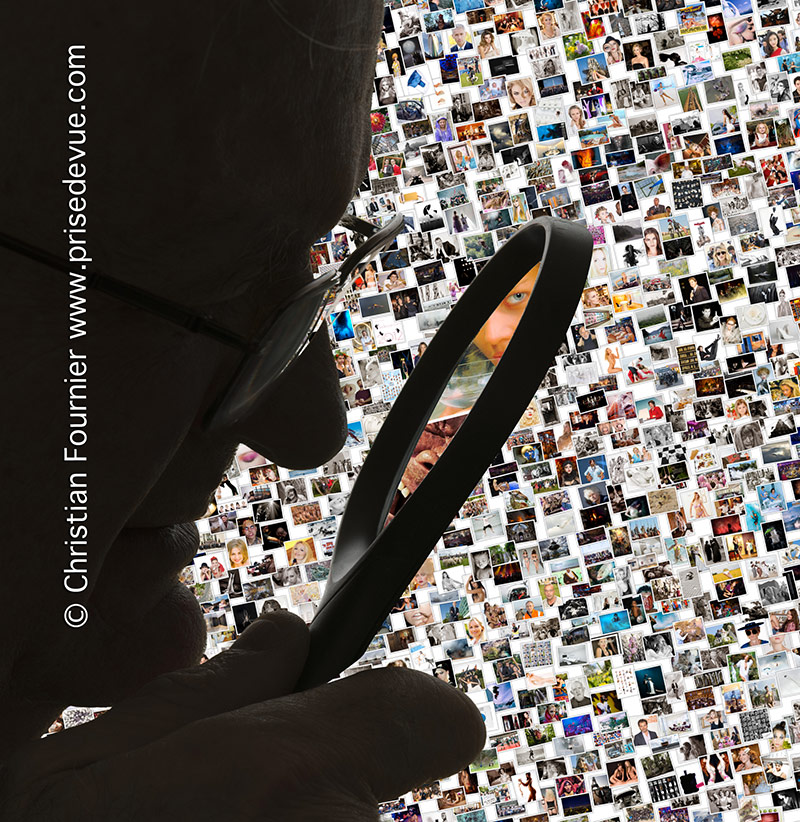 Due to manipulations between prisedevue.photos, prisedevue.photos and famousphotographer.com, some links may be broken. Sorry. I'm working on it ! |
|||||||||||||||||||||||
| ************************* MY BLOGS Not many photographers have the courage to show their photos on a daily basis. I do it to show that in a wide range of photography, I always take good photos for my clients. Technical perfection and an obvious sensitivity. If you imagine the logistic necessary for these missions (estimates, preparations, equipment, transports in traffic jams, safety, etc.), you can see that I am a photographer who achieves results in all circumstances.
************************* |
|||||||||||||||||||||||
 |
CONTACT |
 |
|||||||||||||||||||||
| WWW.FAMOUSPHOTOGRAPHER.COM The archives | |||||||||||||||||||||||
************************* Intellectual Copyright Property 2020 Christian Fournier. All rights are reserved. All texts, photos, graphs, sound files and videos in this website are protected. Their reproduction, modification and uses on other web sites than those by Christian Fournier are strictly forbidden. Most of the photos on my web site are for sale, except, of course, the ones for which I do not have the models or decor releases. I am at your disposal for any query you may have. |
|||||||||||||||||||||||

 |
1 2 3 4 5 6 7 8 9 10 11 12 13 14 15 16 17 18 19 20 21 22 23 24 25 26 27 28 29 30 31 32 33 34 35 36 37 38 39 40 41 42 43 44 45 46 47 48 49 50 51 52 53 54 55 56 57 58 59 60 61 62 63 64 65 66 67 68 69 70 71 72 73 74 75 76 77 78 79 80 81 82 83 84 85 86 87 88 89 90 91 92 93 94 95 96 97 98 99 100 Table of contents |  |



